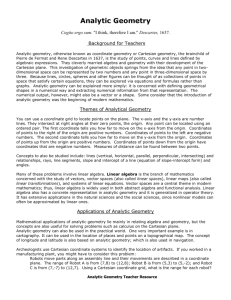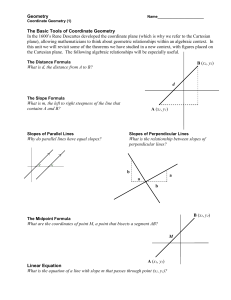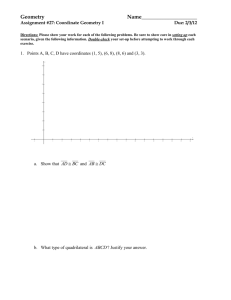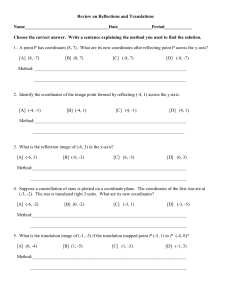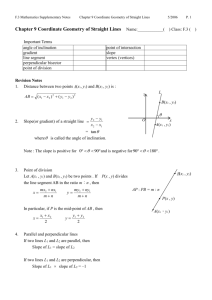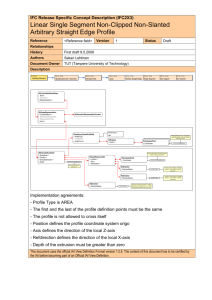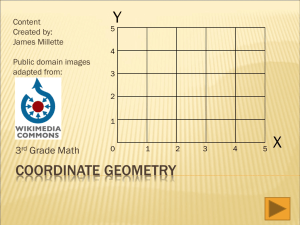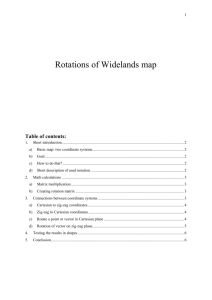Combination of algebra and geometry?Why not.
advertisement
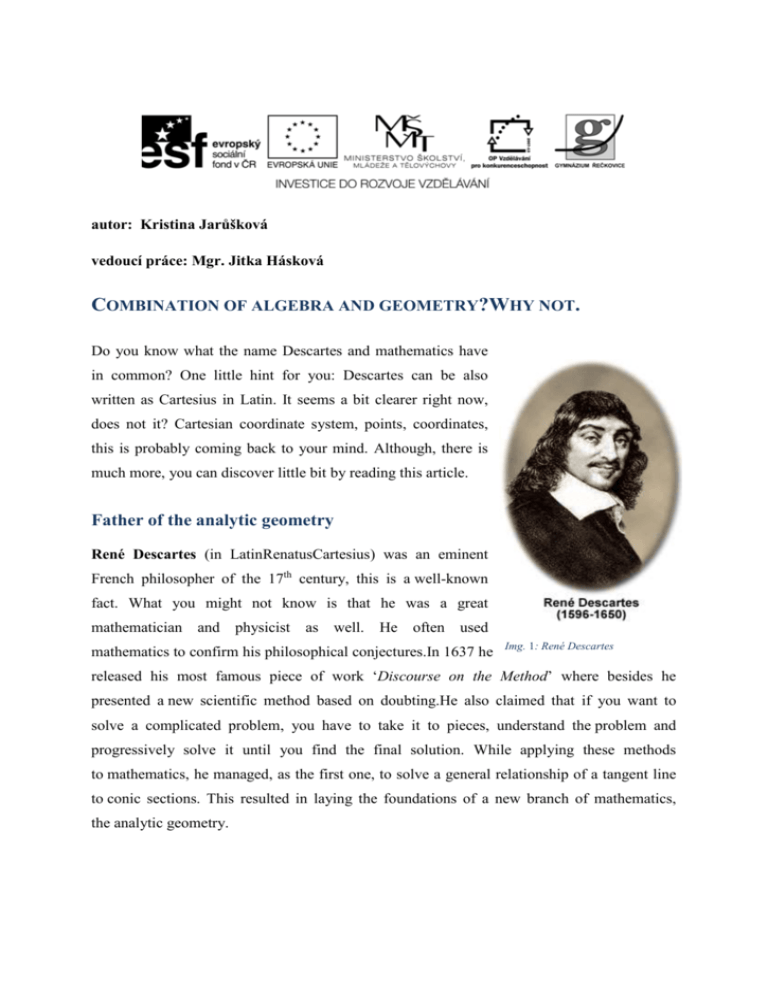
autor: Kristina Jarůšková vedoucí práce: Mgr. Jitka Hásková COMBINATION OF ALGEBRA AND GEOMETRY?WHY NOT. Do you know what the name Descartes and mathematics have in common? One little hint for you: Descartes can be also written as Cartesius in Latin. It seems a bit clearer right now, does not it? Cartesian coordinate system, points, coordinates, this is probably coming back to your mind. Although, there is much more, you can discover little bit by reading this article. Father of the analytic geometry René Descartes (in LatinRenatusCartesius) was an eminent French philosopher of the 17th century, this is a well-known fact. What you might not know is that he was a great mathematician and physicist as well. He often used mathematics to confirm his philosophical conjectures.In 1637 he Img. 1: René Descartes released his most famous piece of work ‘Discourse on the Method’ where besides he presented a new scientific method based on doubting.He also claimed that if you want to solve a complicated problem, you have to take it to pieces, understand the problem and progressively solve it until you find the final solution. While applying these methods to mathematics, he managed, as the first one, to solve a general relationship of a tangent line to conic sections. This resulted in laying the foundations of a new branch of mathematics, the analytic geometry. What is the analytic geometry? To start off we should be familiar with two terms: algebra and geometry. Algebra is a branch of mathematics concerned with relations between numbers. The algebraic expression contains at least one unknown (variable) representing a number we initially don’t know. The equitation can be given as a typical example. Geometry is also a branch of mathematics but it is concerned with shapes, sizes and relative positions of objects and with properties of space. Now we can finally answer the question in the headline. The analytic geometry is a bit more specific branch of mathematics combining algebra and geometry. The beauty of it is that we can express geometric objects using algebraic expressions and we can also add them up, find their size or relative position without making a drawing of them.This is very important for computer software which can solve a problem only by calculating, not by making a construction. Every complicated object in the plane or in the space consists of basic geometric shapes. In the analytic geometry two groups of shapes are distinguished: linear and quadratic. Linear shapes are simpler, it can be a straight line or a plane. Typical representative of quadratic shapes is a conic section, but they are more complicated and we won't follow them up. If we want to describe these shapes, we need to know their position. We have to put them into some coordinate system. Cartesian coordinate system and coordinates of a point You probably know what the Cartesian coordinate system is but we should mention some v description, at least pro forma. In the plane, this coordinate system is a set of two perpendicular lines (axes), usually calledx and y, measured in the same unit of length. The intersection of those lines is called the origin. It is commonly labelled O and its coordinates are (0; 0). The Cartesian coordinate system is labelled Oxy. The coordinates of a point in the plane are written as an ordered pair of numbers (x; y). Ordered pair means that the order of numbers is important, we can't interchange them. For example point A = (2; 1). (Img. 2) Vectors – objects with the direction A few more things still need to be explained, the directed line segment and vector. Then we will show how to express a line using the parametricequation. Unlike a normal line segment, the directed line segment always has an initial point and a terminal point which means that it has not only amagnitude (or length), but also a direction. For example directed line segment AB (Img. 2) has an initial point A = (2; 1) and a terminal point B = (4; 5). Vectors are significant elements in the analytic geometry. It is defined as a set of all directed line segments having the same magnitude and direction. In other words, a vector can be represented by the infinite amount of directed line segments. In the printed text vectors are written in bold letters using italics(v). We can also determinate the coordinates of a vector. Just as the coordinates of a point, the x-coordinate is written as the first and then follows the y-coordinate. For example vector v(Img. 2) has coordinates v = (2; 4). Why? Because v = B A = (b1 – a1; b2 – a2) v = (4 – 2; 5 – 1) = (2; 4). We have a last term to explain, the direction vector. Very simply, it is a vector representing the direction of line. Parametric equation of line General formula of parametric equation is X = A + tu; t ℝ, where A = (a1; a2) is a given point of the line segment, u = (u1; u2) is the direction vector, t is a parameter and X = (x; y) is any point of the line. If we rewrite it for each coordinate, it looks more intelligible: x a1 tu1 p: ; t ℝ. y a2 tu2 Anyway, the best way to understand it is to try it. How about to put the theory into practice? Typical assignment: Find parametric equations of the line qthrough points C = (-1; 3) and D = (5; 1). (Img. 3) We need to know two pieces of information to describe a line, one of its points and its direction vector. In this case, we have only two points but that isn’t a problem. We can calculate the coordinates of the direction vector: u = C D u = (5 (1); 1 3) = (6; 2). u Img. 3: Assignment Finally we know everything we need.Now we just substitute the numbers into the formula. As coordinates of a given point, we can choose either C or D (let’s say we chose C): x 1 6t p: ; t ℝ. y 3 2t And that is all. Now if we substitute the parameter t with any real number, we always find coordinates of a point of the given line. Congratulations if you reached the end of this article. If you find this topic interesting, do not mourn, there are five more ways how to describe just a line in the plane (not talking about planes, quadratic objects and objects in the space). And what is this all good for?Well, the widest use of analytic geometry is definitely in technical fields – construction industry, mechanical engineering, etc. It is also very useful in optics, astrophysics or in a smaller scale in chemistry (to measure distances and angles between atoms and molecules). Ibet that René Descartes did not knowhow important his work will be one day. Sources: "Cartesian coordinate system." Basic-mathematics. n.p., n.d. Web. 2 Jan. 2014. Davidson, Michael W. "René Descartes." Molecularexpressions. Web. 2 Jan. 2014. Jarůšková, Kristina. Středoškolská odborná činnost: Analytická geometrie lineárních útvarů v rovině a její praktické využití. 2013. PDF file.
